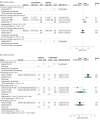Comparison of Acetaminophen (Paracetamol) With Ibuprofen for Treatment of Fever or Pain in Children Younger Than 2 Years: A Systematic Review and Meta-analysis
- PMID: 33125495
- PMCID: PMC7599455
- DOI: 10.1001/jamanetworkopen.2020.22398
Comparison of Acetaminophen (Paracetamol) With Ibuprofen for Treatment of Fever or Pain in Children Younger Than 2 Years: A Systematic Review and Meta-analysis
Abstract
Importance: Acetaminophen (paracetamol) and ibuprofen are the most widely prescribed and available over-the-counter medications for management of fever and pain in children. Despite the common use of these medications, treatment recommendations for young children remain divergent.
Objective: To compare acetaminophen with ibuprofen for the short-term treatment of fever or pain in children younger than 2 years.
Data sources: Systematic search of the databases MEDLINE, Embase, CINAHL, and the Cochrane Central Register of Controlled Trials and the trial registers ClinicalTrials.gov and the Australian New Zealand Clinical Trials Registry from inception to March 2019, with no language limits.
Study selection: Studies of any design that included children younger than 2 years and directly compared acetaminophen with ibuprofen, reporting antipyretic, analgesic, and/or safety outcomes were considered. There were no limits on length of follow-up.
Data extraction and synthesis: Following the Preferred Reporting Items for Systematic Reviews and Meta-analyses (PRISMA) guideline, 2 authors independently extracted data and assessed quality. Data were pooled using a fixed-effects method if I2 was less than 50% and using a random-effects method if I2 was 50% or greater.
Main outcomes and measures: The primary outcomes were fever or pain within 4 hours of treatment onset. Safety outcomes included serious adverse events, kidney impairment, gastrointestinal bleeding, hepatotoxicity, severe soft tissue infection, empyema, and asthma and/or wheeze.
Results: Overall, 19 studies (11 randomized; 8 nonrandomized) of 241 138 participants from 7 countries and various health care settings (hospital-based and community-based) were included. Compared with acetaminophen, ibuprofen resulted in reduced temperature at less than 4 hours (4 studies with 435 participants; standardized mean difference [SMD], 0.38; 95% CI, 0.08-0.67; P = .01; I2 = 49%; moderate quality evidence) and at 4 to 24 hours (5 studies with 879 participants; SMD, 0.24; 95% CI, 0.03-0.45; P = .03; I2 = 57%; moderate-quality evidence) and less pain at 4 to 24 hours (2 studies with 535 participants; SMD, 0.20; 95% CI, 0.03-0.37; P = .02; I2 = 25%; moderate-quality evidence). Adverse events were uncommon. Acetaminophen and ibuprofen appeared to have similar serious adverse event profiles (7 studies with 27 932 participants; ibuprofen vs aceteminophen: odds ratio, 1.08; 95% CI, 0.87-1.33; P = .50, I2 = 0%; moderate-quality evidence).
Conclusions and relevance: In this study, use of ibuprofen vs acetaminophen for the treatment of fever or pain in children younger than 2 years was associated with reduced temperature and less pain within the first 24 hours of treatment, with equivalent safety.
Conflict of interest statement
Figures




References
-
- New Zealand Formulary. New Zealand Formulary for Children. Accessed September 1, 2017. https://nzfchildren.org.nz
-
- Joint Formulary Committee British National Formulary for children. Accessed August 10, 2020. https://bnfc.nice.org.uk
-
- Harriet Lane Service (Johns Hopkins Hospital) The Harriet Lane Handbook: A Manual for Pediatric House Officers. 21st ed. Hughes HK, Kahl LK, eds. Elsevier; 2018.
Publication types
MeSH terms
Substances
LinkOut - more resources
Full Text Sources
Medical

